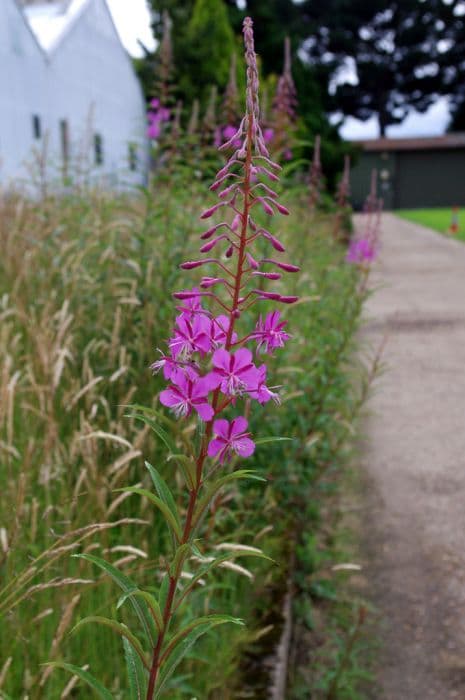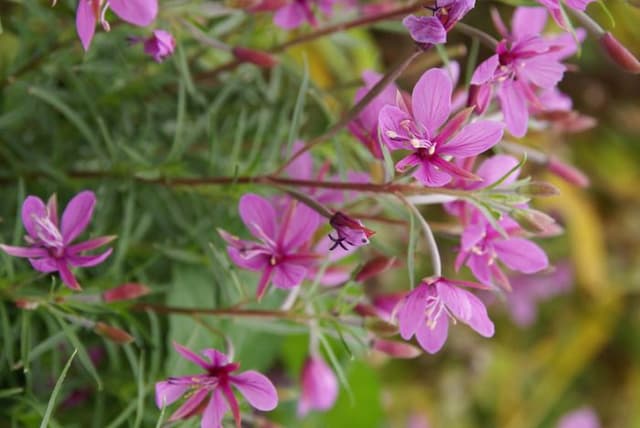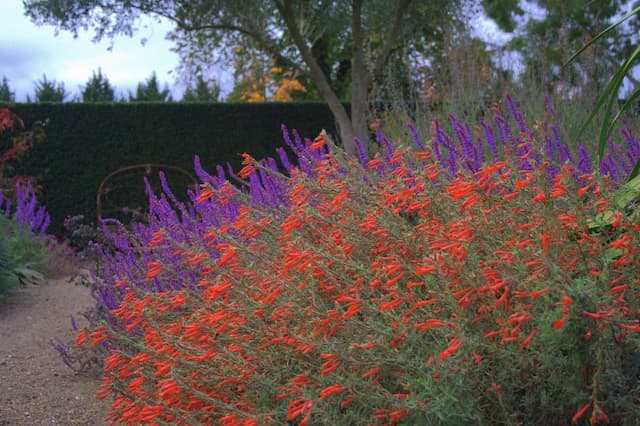Hardy fuchsia Fuchsia 'Riccartonii'

ABOUT
Fuchsia 'Riccartonii' is a vibrant and showy plant, renowned for its spectacular flowers. The blossoms are a beautiful combination of deep purple and bright red, with teardrop-shaped petals that dangle elegantly from the stems. These flowers have a distinctive, pendant-like appearance, resembling small, graceful lanterns and are often surrounded by delicate green to dark green foliage. The leaves themselves are small to medium in size, with a slightly elongated shape and soft texture, presenting a lovely backdrop that contrasts with the vivid hues of the blooms. The branches of the Fuchsia 'Riccartonii' are slender and may arch gracefully, adding to the overall aesthetic of the plant with their gentle, cascading effect that showcases the flowers. In essence, this plant is characterized by its striking flowers and the refined, subtle beauty of its foliage and growth habit, making it a favored choice for gardens and containers where its ornamental appeal can be fully appreciated.
About this plant
 Names
NamesFamily
Onagraceae.
Synonyms
Lady's Eardrops, Hardy Fuchsia, Hummingbird Fuchsia, Riccartonii.
Common names
Fuchsia 'Riccartonii'.
 Toxicity
ToxicityTo humans
The Fuchsia, specifically the variety 'Riccartonii', is generally considered non-toxic to humans. There is no significant evidence that the ingestion of any part of this plant leads to poisoning or adverse health consequences in humans. However, like with any non-food plant, individual sensitivities can vary, and consuming plant parts might still cause mild stomach upset or allergic reactions in some people. It is always prudent to avoid eating ornamental plants.
To pets
The Fuchsia, including the variety 'Riccartonii', is generally considered non-toxic to pets such as cats and dogs. There is no widespread documentation of poisoning from pets ingesting this plant. While it is unlikely to cause harm, ingestion of non-food plants can sometimes result in gastrointestinal irritation or mild digestive upset in pets. If a pet ingests a significant amount of the Fuchsia or shows any signs of distress, it is advisable to consult a veterinarian.
 Characteristics
CharacteristicsLife cycle
Perennials
Foliage type
Deciduous
Color of leaves
Green
Flower color
Mixed
Height
4-6 feet (1.2-1.8 meters)
Spread
4-6 feet (1.2-1.8 meters)
Plant type
Shrub
Hardiness zones
7
Native area
Central and South America
Benefits
 General Benefits
General Benefits- Ornamental Value: The Fuchsia 'Riccartonii', commonly known as Hardy Fuchsia, is widely appreciated for its striking and pendulous purple and red flowers that add aesthetic appeal to gardens and landscapes.
- Attracts Pollinators: Hardy Fuchsia flowers are known to attract hummingbirds and bees, which are beneficial for pollinating other plants in the garden.
- Long Flowering Season: This plant has a long blooming period, often from summer through fall, providing extended visual interest in the garden.
- Shade Tolerance: Hardy Fuchsia can thrive in partial shade conditions where other flowering plants might not perform as well, offering flexibility in garden design.
- Versatility: It can be grown in a variety of settings including borders, containers, and as a specimen plant, making it versatile for different garden styles and sizes.
- Low Maintenance: Once established, Hardy Fuchsia requires relatively low maintenance, making it suitable for gardeners of all skill levels.
- Cold Hardy: This variety of Fuchsia is more cold-resistant than many others, allowing it to survive in cooler climates where other Fuchsias cannot.
 Medical Properties
Medical PropertiesThis plant is not used for medical purposes.
 Air-purifying Qualities
Air-purifying QualitiesThis plant is not specifically known for air purifying qualities.
 Other Uses
Other Uses- Fuchsia 'Riccartonii' can be used as a natural dye source. The flowers and berries of the fuchsia plant can be used to obtain vibrant dye colors for fabrics and other materials.
- They can provide habitat and food for hummingbirds and other nectar-seeking species, enhancing biodiversity in your garden.
- Fuchsia can be used in educational projects to teach about plant biology and hybridization due to its various crossbred varieties.
- Their branches and foliage can be incorporated into floral arrangements and wreaths for decoration purposes, adding a splash of color.
- Fuchsia berries, although not widely known for edibility, are actually edible and can be used to make jams and jellies.
- The plant can be grown as a living fence or privacy screen, which in full bloom, creates a visually stunning barrier.
- Artists and photographers may utilize fuchsia's attractiveness for still life art, nature photography, and botanical illustration.
- Fuchsia can be used in potted combinations with other plants to create dynamic visual displays on balconies and patios.
- They can be cultivated for competitive showing in horticultural contests, where different cultivars are judged on their beauty and form.
- Their dropped petals can be utilized in potpourri mixes, adding color and a subtle fragrance to a room.
Interesting Facts
 Feng Shui
Feng ShuiThe Fuchsia is not used in Feng Shui practice.
 Zodiac Sign Compitability
Zodiac Sign CompitabilityThe Fuchsia is not used in astrology practice.
 Plant Symbolism
Plant Symbolism- Good Taste: Fuchsia, with its elegant, drooping bell-like flowers, often symbolizes good taste and sophistication. 'Riccartonii', with its deep red and purple hues, accentuates this symbolism through its rich coloration.
- Confiding Love: The hanging blossoms of the Fuchsia can be seen as a symbol of trust and confiding, the way one might whisper into a loved one's ear, portraying a personal and deep connection.
- Overflowing Abundance: Fuchsias tend to produce a profusion of flowers throughout the growing season, making them a symbol of abundance and overflowing bounty.
- Grace Under Pressure: The delicate-looking flowers of the Fuchsia plant hold up under a range of conditions and can withstand significant weather variations, representing resilience and poise even in challenging circumstances.
- Amiability: Fuchsia 'Riccartonii', often found in hospitable garden settings, can symbolize amiability and warmth of character, illustrating a welcoming environment.
 Water
WaterLady's eardrops require regular watering to maintain moist but not waterlogged soil. During the growing season, typically from spring through late summer, water the plant when the top inch of soil feels dry to the touch, which might be twice a week. Ensure you're providing around an inch of water each time, depending on weather conditions. During the winter months, reduce watering to once a week or whenever the soil is mostly dry. Over-watering can lead to root rot, so make sure to have proper drainage.
 Light
LightLady's eardrops thrive in bright, indirect light but are also tolerant of partial shade. An ideal spot would be a location that gets morning sunlight and afternoon shade, or dappled shade throughout the day. Avoid placing them in full, direct afternoon sun, which can scorch the leaves and flowers.
 Temperature
TemperatureLady's eardrops prefer a mild temperature range between 60 to 70 degrees Fahrenheit. They can withstand a minimum temperature of around 40 degrees Fahrenheit and should not be exposed to temperatures below this. The ideal growing conditions would be consistent temperatures within this range, avoiding sudden drops or spikes in temperature, which can be stressful for the plant.
 Pruning
PruningPruning Lady's eardrops is essential for encouraging bushy growth and abundant blooming. Prune the plant in late winter or early spring before new growth begins. Remove any dead or damaged wood and cut back a third to half of the plant to promote new growth and a compact habit. The best time for pruning is when there's no risk of frost and the plant has finished its winter dormancy.
 Cleaning
CleaningAs needed
 Soil
SoilLady's eardrops, or Fuchsia 'Riccartonii', thrive in a soil mix that is rich, moist, and well-draining, with a pH between 6.0 and 7.0. A good recipe for soil mix is one part peat moss, one part loam, and one part perlite or sand to ensure proper drainage.
 Repotting
RepottingLady's eardrops should be repotted every 2-3 years or when the plant becomes root-bound. Choose a pot only slightly larger than the previous one to ensure continued growth.
 Humidity & Misting
Humidity & MistingLady's eardrops prefer high humidity levels, ideally between 60% and 70%. Positioning the plant over a pebble tray with water or using a humidifier can help maintain these conditions.
 Suitable locations
Suitable locationsIndoor
Keep Lady's eardrops in bright, indirect light and high humidity.
Outdoor
Grow Lady's eardrops in partial shade and sheltered from strong winds.
Hardiness zone
6-9 USDA
 Life cycle
Life cycleFuchsia 'Riccartonii', commonly known as hardy fuchsia, begins its life cycle when seeds germinate in spring, given warm temperatures and moist soil conditions. After germination, seedlings emerge and grow into young plants with characteristic fleshy leaves and a bushy growth habit, which can take several weeks to months depending on conditions. Once mature, the hardy fuchsia typically blooms throughout the summer months, producing pendulous, tubular flowers that are predominantly purple and red. Pollination occurs through the activity of hummingbirds and insects, leading to the formation of small, dark berries containing seeds. As autumn approaches, growth slows and the plant may drop leaves, entering a period of dormancy in winter, especially in cooler climates. In spring, the plant breaks dormancy, resuming growth, and the cycle repeats, with the fuchsia potentially living for several years, particularly if properly pruned and cared for.
 Propogation
PropogationPropogation time
Spring-Early Summer
Propogation: The most popular method of propagating Fuchsia 'Riccartonii', commonly known as the hardy fuchsia, is through softwood cuttings. This is best done in spring to early summer when new growth is green and pliable. Cut a 4 to 6 inch (10 to 15 cm) stem, just below a leaf node, and remove the lower leaves. Dip the cut end in rooting hormone to encourage root development. Place the cutting in a pot filled with a mix of equal parts peat and perlite or a well-draining potting mix. Cover the cutting with a plastic bag or place it in a propagator to maintain humidity levels. Keep the cutting in indirect light and make sure the soil stays moist but not waterlogged. Roots typically develop within 3 to 4 weeks, after which you can transplant the cutting into a larger pot or into the garden.









